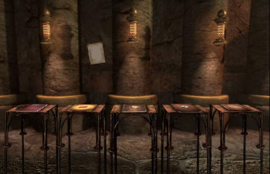Reference:Gehn, Riven Journals (website)
This article contains apocryphal content. It should be considered non-canon and may consist of fan-created content. |
 | |
| Location |
|
|---|---|
| Author | Gehn |
According to RAWA, the Riven Journals are apocryphal content and should not be relied on to be accurate or reliable sources of information. |
Journal 1[edit | edit source]
Even as I write this, the ink refuses to stay grounded to the surface. And what remains is more surprising still. Certainly this is some unique variant of the Art.
Harvesting the raw materials for writing began with the felling of trees. From these laborious yet fruitful efforts, I have found purpose in my days here.
Likewise, the acquisition of ink has given rise to beautifully functional reservoirs, each elegantly symbolizing the ink's source. Of all the elements, ink is the most critical, as well as the most difficult to acquire.
With the flowing of a hidden current, the chamber's foundation aligns the elements in a symbolic unit. Such is the cyclical nature of the Art.
Inscriptions give testament to our achievements. No detail is incidental to the Whole -- and this final one is no exception. Knowledge, united in word and form, pays tribute to our most critical resource.
Journal 2[edit | edit source]
The waters surrounding this penitential promontory have the most curious assortment of creatures. One unique species of aquatic beings in particular draws my interest and is worthy of scientific observation. With their lumbering bodies and strangely delicate flipper appendages, these mammals seem like refugees from some bygone era.
The creatures find sustenance in a manner that belies their physical size. Using an efficient baleen feeding mechanism, they survive by ingesting the colonies of microscopic organisms that thrive in these waters.
As passive as these beasts are in their quest for food, they are themselves simply another link in the chain. The perennial predator, man, remains at the top of that order. Ironically, the children of the inhabitants seem to love this creature -- drawing countless pictures in adoration of that same mammoth body which the elders would just as soon harpoon for the evening meal.
The islanders use the generous pelts of these animals to make rudimentary clothing and pouches. Through objects made from their distinctive dual-colored hides, these animals manifest their particular characteristics even after death.
As for the creature's origin itself, I can but only speculate. What evolutionary anomaly could have resulted in such an impressive oddity?
Journal 3[edit | edit source]
It is hereby decreed that the members of this Guild pursue the design of a mechanized transport system. It shall be adequate to span the increasing separation of land masses in this wholly unstable Age.
distant view -- typical shifting land mass note: most bridges have fared well, but the more significant tectonic plate shifts have rendered several useless for such long spans
side elevation -- proposed transport vehicle
detail, plan view -- vehicle control
detail elevation -- magnetic coil note: it will be imperative that each magnetic coil be given the identical amount of power
front elevation note: slight imperfections in the metal may affect the symmetry of the transport's magnetic fields a balance is achievable, though calculations anticipate the functional power distribution to be a full seven units below the optimum fifty-five
Journal 4[edit | edit source]
Countless generations ago, before the Great Exodus, there was a courageous D'ni explorer named Klvino who was the first to travel to another world without the aid of descriptive books. Klvino, a nobleman of the highest ranks, engineered an astounding craft unlike any other for physical transport from the confines of the known stars.
Ever cautious, he kept a sole linking book close to an Age he called "Haven" where his wife and child waited in anticipation of his return.
He traveled in silent isolation for several years before his craft's instruments confirmed a celestial body with an accommodating environment. He described it as "having a unique aura unlike any other that has presented itself before me. Surely this is a good omen"
This omen did indeed indicate good fortune for Klvino, if only for a brief time. With a keen ability to assimilate into this newfound world, he lived among them covertly as a "traveler from across the seas." He quickly learned the language, customs and technology and, befitting his nature, became well respected in their community.
Days prior to the completion of his study and anticipated return home, his star craft was discovered by the native inhabitants. In violent reaction to what they deemed was a betrayal beyond reprieve, Klvino was sentenced to death.
His body was severed into five parts, which were distributed across the land and sea as a warning to others. His single valued possession, the linking book, was then fed to a sea beast -- the inverted remains of which linked to the feet of Klvino's grief stricken family.
From that point out, the D'ni Maintainers used this story in all aspects concerning outside contact. A spherical time translator for converting D'ni time to surface time uses this tale as a symbolic reminder. This device, engraved with a map of Klvino's vindictive world, must be held at the five points where his body was distributed. Applying pressure sequentially with a final touch of the sea beast opens the timepiece. It serves as a constant reminder to be wary of contact with worlds over which you have no influence or control.